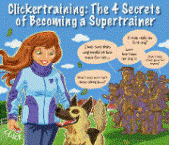Good Dog Training Advice
Get Fast & Simple Dog Training Tips to
Turn a Difficult Dog Into an Obedient Pet!
What Really is Dog Language?
Every now and then you hear someone say "dog language". But, what exactly are they talking about? Are dogs
actually talking to each other in some hidden, silent language we cannot hear? Or is it something much more
complex than that?
The truth is that dogs don't think in terms of what we consider "language". That's a human construct. However, communication exists for every animal species, and dogs are no different. Using a series of body language cues and sounds, dogs can tell each other what they feel and want quite effectively. As human beings, it is extremely useful to know what your dog is trying to say to you with their body language. It can also help to reduce the potential for aggression or violence outside your home if you can recognize when your dog is upset or angry.
The Various Signs of Dog Language
Because there is no syntax or set rule book for dogs and how they talk to us, here are some of the most important physical cues you'll receive from your dog. * Stillness - When a dog stops moving and stands very still, it often means they want to be left alone and that they are fearful of losing something. Give your dog a bone and see if they do this. It can be dangerous to try and interact with them in this state (if you're not the clear leader of the pack). * Growling and Teeth - There are multiple stages in showing a threat. It starts with the teeth being bared. Many people tell their dogs to stop doing this, but it's best to leave this behaviour alone instead of trying to correct it with dog behavior training. Despite how scary it is, teeth baring is a clear warning sign to people and animals that a dog is upset and wants to be left alone. Growling comes next, followed by attacking. If you train your dog not to bare its teeth or growl, they may escalate straight to attacking. * Arched Backs - When a dog arches his back, they are trying to look bigger to scare off a threat. It generally means they are scared and a scared dog is a dangerous dog. If you see this in another dog, it's best to leave them alone. * Tail between their Legs - A dog's tail between its legs means it is scared or anxious. This can be the result
of many sources, including simply their owner leaving the house. * Raised Paw -A raised paw means that the dog wants to be your friend. It's why this is so easy to train a dog
to do. Dogs are extremely expressive. For many people, the biggest problem in training is that we don't pay attention
to what they're trying to tell us. Learning how to read dog body
language will definitely enable you understand your dog better. They, on the other hand, read every gesture we
make. Whether you try to hide it or not, a dog will know when you're upset or happy or angry based almost entirely
on body language.
Click here now => http://gooddogtrainingadvice.com/dogtutor.html | |
|


Discover the Secrets to Training Your Dog Or Puppy. Huge BONUSES for a limited time only!
Click here now...
|
http://GoodDogTrainingAdvice.com






